The United Kingdom, made up of England, Scotland, Wales and Northern Ireland, is an island nation in northwestern Europe. England – birthplace of Shakespeare and The Beatles – is home to the capital, London, a globally influential centre of finance and culture. England is also site of Neolithic Stonehenge, Bath’s Roman spa and centuries-old universities at Oxford and Cambridge.
The area now called England was first inhabited by modern humans during the Upper Paleolithic period, but takes its name from the Angles, a Germanic tribe deriving its name from the Anglia peninsula, who settled during the 5th and 6th centuries. England became a unified state in the 10th century and has had a significant cultural and legal impact on the wider world since the Age of Discovery, which began during the 15th century. The English language, the Anglican Church, and English law—the basis for the common law legal systems of many other countries around the world—developed in England, and the country’s parliamentary system of government has been widely adopted by other nations. The Industrial Revolution began in 18th-century England, transforming its society into the world’s first industrialised nation.
English Heritage is a governmental body with a broad remit of managing the historic sites, artefacts and environments of England. It is currently sponsored by the Department for Digital, Culture, Media and Sport.
The National Trust for Places of Historic Interest or Natural Beauty is a charity which also maintains multiple sites. Of the 25 United Kingdom UNESCO World Heritage Sites, 17 are in England.
Some of the best known of these include Stonehenge, Avebury and Associated Sites, Tower of London, Jurassic Coast, Palace of Westminster, Roman Baths, City of Bath, Saltaire, Ironbridge Gorge, Studley Royal Park and more recently the English Lake District. The northernmost point of the Roman Empire, Hadrian’s Wall, is the largest Roman artefact anywhere: it runs for a total of 73 miles in northern England.
The Secretary of State for Digital, Culture, Media and Sport has overall responsibility for tourism, arts and culture, cultural property, heritage and historic environments, libraries, and museums and galleries.The Parliamentary Under Secretary of State for Arts, Heritage and Tourism is the minister with responsibility over tourism in England.
1.Tower of London
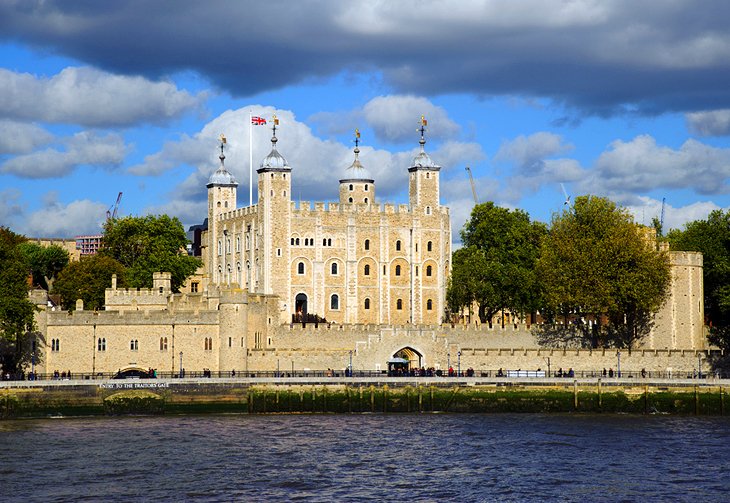
The Tower of London, officially Her Majesty’s Royal Palace and Fortress of the Tower of London, is a historic castle on the north bank of the River Thames in central London. It lies within the London Borough of Tower Hamlets, which is separated from the eastern edge of the square mile of the City of London by the open space known as Tower Hill. It was founded towards the end of 1066 as part of the Norman Conquest. The White Tower, which gives the entire castle its name, was built by William the Conqueror in 1078 and was a resented symbol of oppression, inflicted upon London by the new ruling elite. The castle was also used as a prison from 1100 (Ranulf Flambard) until 1952 (Kray twins),[3] although that was not its primary purpose. A grand palace early in its history, it served as a royal residence. As a whole, the Tower is a complex of several buildings set within two concentric rings of defensive walls and a moat. There were several phases of expansion, mainly under kings Richard I, Henry III, and Edward I in the 12th and 13th centuries. The general layout established by the late 13th century remains despite later activity on the site.
The Tower of London has played a prominent role in English history. It was besieged several times, and controlling it has been important to controlling the country. The Tower has served variously as an armoury, a treasury, a menagerie, the home of the Royal Mint, a public record office, and the home of the Crown Jewels of England. From the early 14th century until the reign of Charles II in the 17th century, a procession would be led from the Tower to Westminster Abbey on the coronation of a monarch. In the absence of the monarch, the Constable of the Tower is in charge of the castle. This was a powerful and trusted position in the medieval period. In the late 15th century, the Princes in the Tower were housed at the castle when they mysteriously disappeared, presumed murdered. Under the Tudors, the Tower became used less as a royal residence, and despite attempts to refortify and repair the castle, its defences lagged behind developments to deal with artillery.
2.The Roman Baths and Georgian City of Bath

The Roman Baths are well-preserved thermae in the city of Bath, Somerset, England. A temple was constructed on the site between 60-70AD in the first few decades of Roman Britain. Its presence led to the development of the small Roman urban settlement known as Aquae Sulis around the site.
The Roman Baths are preserved in four main features: the Sacred Spring, the Roman Temple, the Roman Bath House, and a museum which holds artefacts from Aquae Sulis. However, all buildings at street level date from the 19th century. It is a major tourist attraction in the UK, and together with the Grand Pump Room, receives more than 1.3 million visitors annually. Visitors can tour the baths and museum but cannot enter the water.
The Roman Baths are no longer used for bathing. In October 1978, a young girl swimming in the restored Roman Bath with the Bath Dolphins, a local swimming club, contracted meningitis and died,[6] leading to the closure of the bath for several years. Tests showed Naegleria fowleri, a deadly pathogen, in the water. The newly constructed Thermae Bath Spa nearby, and the refurbished Cross Bath, allow modern-day bathers to experience the waters via a series of more recently drilled boreholes.
3.The British Museum
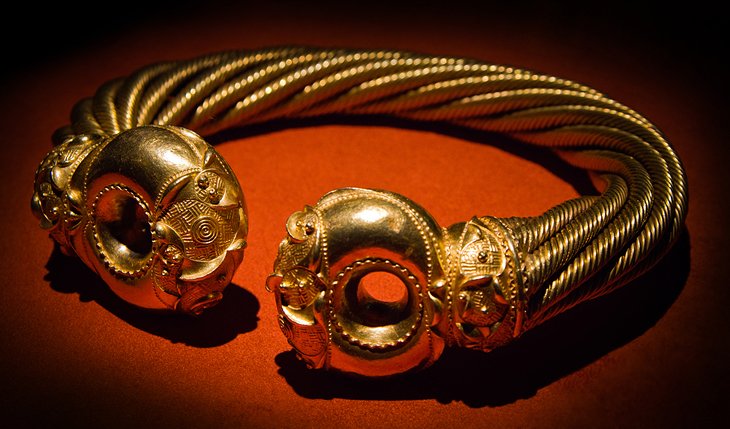
The British Museum is a public museum dedicated to human history, art and culture located in the Bloomsbury area of London. Its permanent collection of eight million works is among the largest and most comprehensive in existence. It documents the story of human culture from its beginnings to the present.
The British Museum is a public museum dedicated to human history, art and culture located in the Bloomsbury area of London. Its permanent collection of eight million works is among the largest and most comprehensive in existence. It documents the story of human culture from its beginnings to the present.[a] The British Museum was the first public national museum in the world.
The Museum was established in 1753, largely based on the collections of the Anglo-Irish physician and scientist Sir Hans Sloane. It first opened to the public in 1759, in Montagu House, on the site of the current building. The museum’s expansion over the following 250 years was largely a result of British colonisation and has resulted in the creation of several branch institutions, or independent spin-offs, the first being the Natural History Museum in 1881.
4.York Minster and Historic Yorkshire

The magnificent York Minster is second in importance in the Church of England only to the cathedral at Canterbury. It stands in the center of historic York, surrounded by half-timbered homes and shops, medieval guildhalls, and churches.
In turn, York’s romantic streets are surrounded by three miles of magnificent town walls that you can walk atop for spectacular views over the city and its surroundings. While here, visit the National Railway Museum, one of England’s most visited tourist attractions.
York is also a good base from which to explore northeast England, in particular the rugged beauty of the Yorkshire Dales and the North York Moors. Elsewhere in this corner of the country, you’ll find some of England’s most beautiful historic towns and cities, including Durham – famous for its castle and cathedral – and Beverley, which also boasts an attractive minster.
5.Tate Modern
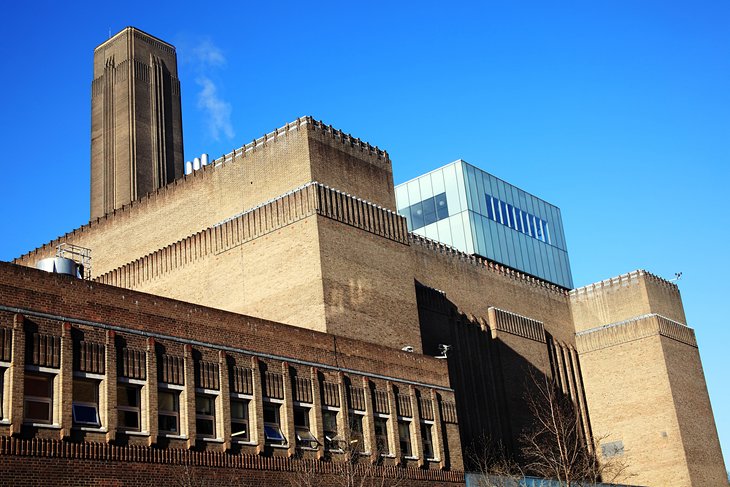
Tate is an institution that houses, in a network of four art galleries, the United Kingdom’s national collection of British art, and international modern and contemporary art. It is not a government institution, but its main sponsor is the UK Department for Digital, Culture, Media and Sport.
Tate Modern is an art gallery located in London. It houses the United Kingdom’s national collection of international modern and contemporary art, and forms part of the Tate group together with Tate Britain, Tate Liverpool and Tate St Ives. It is located in the former Bankside Power Station, in the Bankside area of the London Borough of Southwark.
Tate Modern is one of the largest museums of modern and contemporary art in the world. As with the UK’s other national galleries and museums, there is no admission charge for access to the collection displays, which take up the majority of the gallery space, whereas tickets must be purchased for the major temporary exhibitions. Due to the COVID-19 pandemic the museum was closed for 173 days in 2020, and attendance plunged by 77 per cent to 1,432,991 in 2020. Nonetheless, the Tate was third in the list of most-visited art museums in the world in 2020, and the most visited in Britain. The nearest railway and London Underground station is Blackfriars, which is 0.5 km from the gallery.
6.Warwick Castle
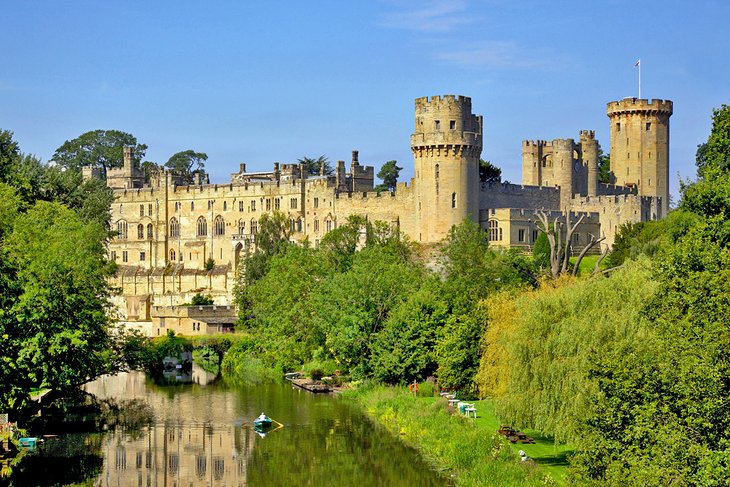
Warwick Castle is a medieval castle developed from a wooden fort, originally built by William the Conqueror during 1068. Warwick is the county town of Warwickshire, England, situated on a meander of the River Avon. The original wooden motte-and-bailey castle was rebuilt in stone during the 12th century. During the Hundred Years War, the facade opposite the town was refortified, resulting in one of the most recognisable examples of 14th-century military architecture. It was used as a stronghold until the early 17th century, when it was granted to Sir Fulke Greville by James I in 1604. Greville converted it to a country house, and it was owned by the Greville family (who became Earls of Warwick in 1759) until 1978, when it was bought by the Tussauds Group.
In 2007, the Tussauds Group was purchased by the Blackstone Group, which merged it with Merlin Entertainments. Warwick Castle was then sold to Nick Leslau’s investment firm, Prestbury Group, under a sale and leaseback agreement. Merlin continues to operate the site under a renewable 35-year lease.
Warwick Castle is situated in the town of Warwick, on a sandstone bluff at a bend of the River Avon. The river, which runs below the castle on the east side, has eroded the rock the castle stands on, forming a cliff. The river and cliff form natural defences. When construction began in 1068, four houses belonging to the Abbot of Coventry were demolished to provide space. The castle’s position made it strategically important in safeguarding the Midlands against rebellion. During the 12th century, King Henry I was suspicious of Roger de Beaumont, 2nd Earl of Warwick. To counter the earl’s influence, Henry bestowed Geoffrey de Clinton with a position of power rivalling that of the earl. The lands he was given included Kenilworth – a castle of comparable size, cost, and importance, founded by Clinton – which is about 8 kilometres (5 mi) to the north. Warwick Castle is about 1.6 kilometres (1 mi) from Warwick railway station and less than 3.2 kilometres (2.0 mi) from junction 15 of the M40 motorway; it is also relatively close to Birmingham Airport.
7.The National Gallery
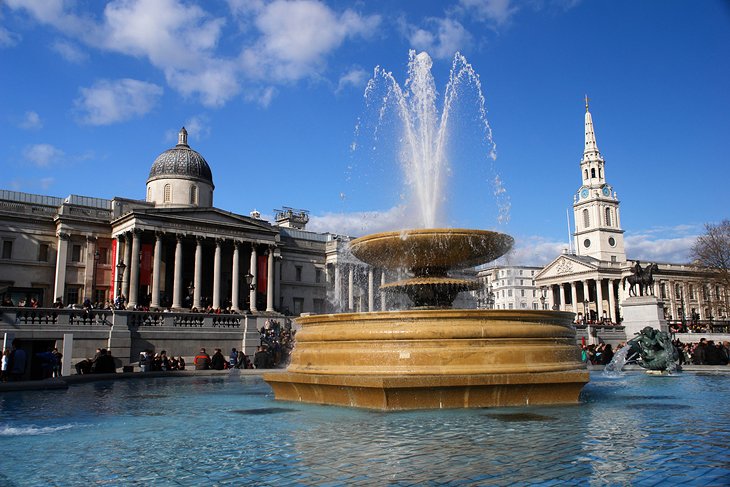
The National Gallery is an art museum in Trafalgar Square in the City of Westminster, in Central London. Founded in 1824, it houses a collection of over 2,300 paintings dating from the mid-13th century to 1900.
The Gallery is an exempt charity, and a non-departmental public body of the Department for Digital, Culture, Media and Sport. Its collection belongs to the government on behalf of the British public, and entry to the main collection is free of charge. In 2020, due to the COVID-19 pandemic it attracted only 1,197,143 visitors, a drop of 50 per cent from 2019, but it still ranked eighth on the list of most-visited art museums in the world.
Unlike comparable museums in continental Europe, the National Gallery was not formed by nationalising an existing royal or princely art collection. It came into being when the British government bought 38 paintings from the heirs of John Julius Angerstein in 1824. After that initial purchase, the Gallery was shaped mainly by its early directors, especially Charles Lock Eastlake, and by private donations, which now account for two-thirds of the collection.The collection is smaller than many European national galleries, but encyclopaedic in scope; most major developments in Western painting “from Giotto to Cézanne” are represented with important works. It used to be claimed that this was one of the few national galleries that had all its works on permanent exhibition, but this is no longer the case.









